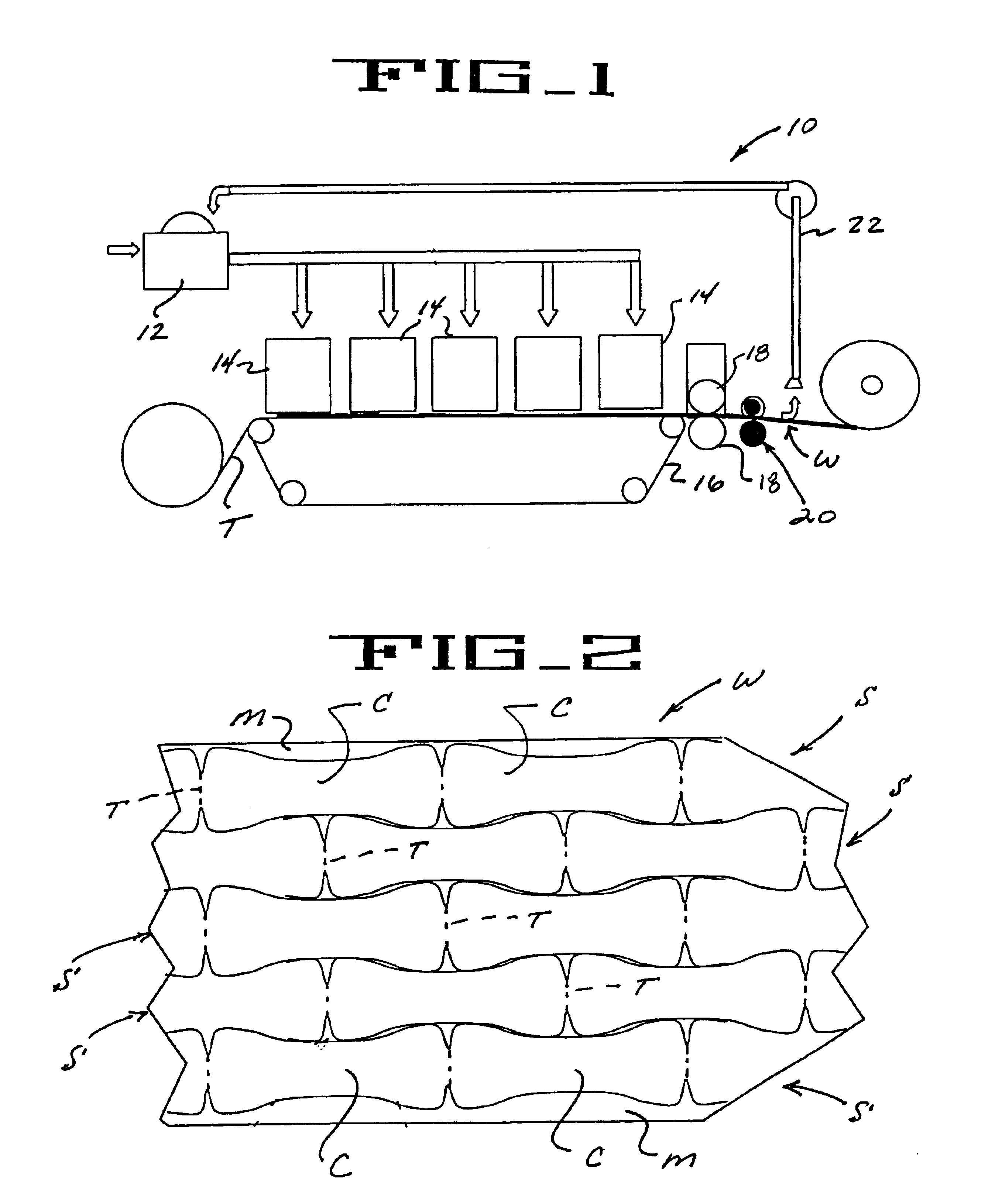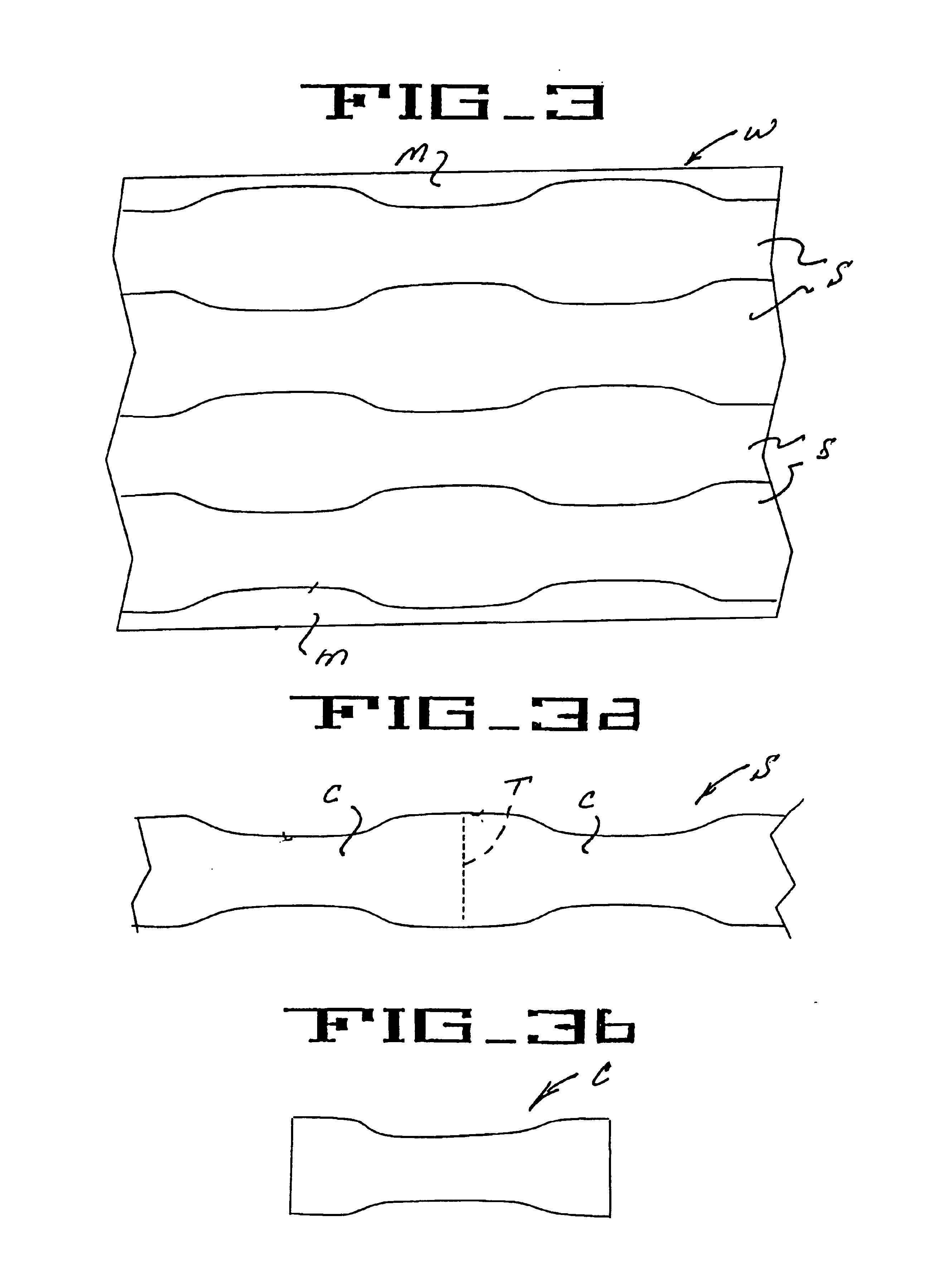Method of making shaped components for disposable absorbent articles
- Summary
- Abstract
- Description
- Claims
- Application Information
AI Technical Summary
Benefits of technology
Problems solved by technology
Method used
Image
Examples
example 1
[0090]This example of the present system concerns formation of an absorbent core for a disposable diaper. The core is 90 mm in the narrowest portion of the crotch, with a core length of 400 mm. The widest portion of the core is 110 mm. The core is symmetrical longitudinally and about a transverse centerline running across the midpoint of the core. The pattern is a fully complementary, hourglass shape, such as illustrated in FIG. 4, thus allowing the adjacent subdivided webs to be juxtaposed, without material removed from therebetween. The core consists of air-laid material having a basis weight of 500 grams per square meter, with 55% superabsorbent polymer by weight. The balance of the air-laid consists, by weight, of cellulosic fibers in the form of defiberized wood pulp, or carrier tissue. The density of the air-laid web is 0.35 grams per cc. The air-laid web W is 915 mm wide. The nested pattern allows the web W to be slit into nine subdivided webs S. The marginal edge trim for an...
example 2
[0091]This example also contemplates formation of shaped components for use as an absorbent core for a disposable diaper. The absorbent core has dimensions similar to those disclosed above in connection with Example 1, with a crotch width of 90 mm, a maximum width of 110 mm, and a core length of 400 mm. The pattern is symmetrical about a longitudinal centerline of each component, with adjacent subdivided webs being fully complementary. However, generally as illustrated in FIG. 5, this shaped component configuration is asymmetrical about the transverse centerline of each component. This results from the narrowest portion of the crotch region of each core being positioned forwardly of a transverse centerline of each core, with the slope of the rear core ear portions being flatter than that of the front core ear portions. The core consists of an air-laid material having a basis weight of 500 grams per square meter, with 55%, by weight, of superabsorbent polymer. The balance of the air-...
example 3
[0092]This example concerns formation of absorbent cores for sanitary napkins employing the present system. Each core is 215 mm long, with a minimum width of 65 mm near the mid-point, and a maximum width of 80 mm near the ends. The ends are rounded on the four corners with a 30 mm radius. The cores are attached to one another longitudinally with a narrow 20 mm neck, which is intended to be cut relatively precisely with the transverse cutting blade for formation of cuts T (see FIG. 6). The air-laid web is 915 mm wide. The cores are nested (but adjacent subdivided webs are non-complementary) so that 12 subdivided webs can be obtained. With a surface area of 189.57 square centimeters per core, the resulting recycle is 9.6% of the wide web from which the shaped components are formed.
[0093]In a system where a transverse knife cut is to be formed, the shaped pattern of the shaped components may neck inwardly at the ends, thus becoming very narrow at the point where the knife cuts are made...
PUM
 Login to View More
Login to View More Abstract
Description
Claims
Application Information
 Login to View More
Login to View More - R&D
- Intellectual Property
- Life Sciences
- Materials
- Tech Scout
- Unparalleled Data Quality
- Higher Quality Content
- 60% Fewer Hallucinations
Browse by: Latest US Patents, China's latest patents, Technical Efficacy Thesaurus, Application Domain, Technology Topic, Popular Technical Reports.
© 2025 PatSnap. All rights reserved.Legal|Privacy policy|Modern Slavery Act Transparency Statement|Sitemap|About US| Contact US: help@patsnap.com



